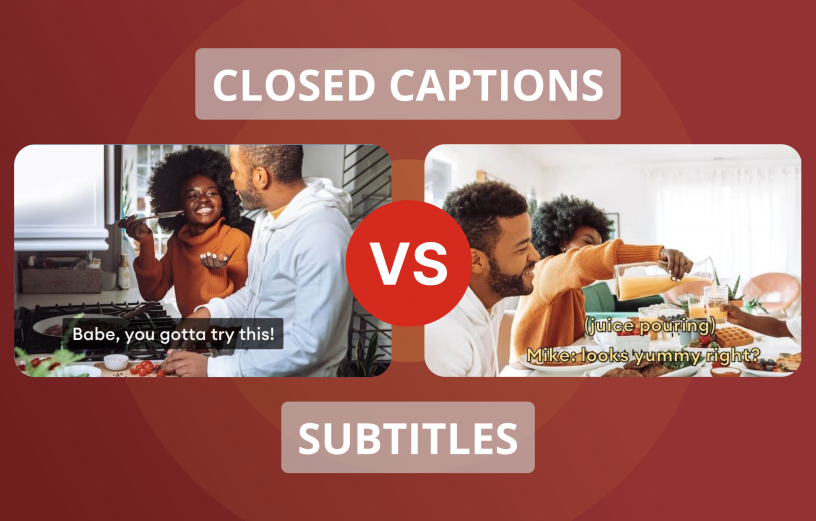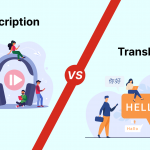
Did You Know? Over 466 million people worldwide live with hearing loss and many more struggle with understanding foreign languages. Luckily, a powerful tool exists to bridge these gaps: captions and subtitles. But are they the same thing?
While both appear as text on your screen, captions and subtitles serve distinct purposes and cater to different audiences. Understanding these differences is crucial for effectively using them and ensuring your video content is accessible to everyone. Let’s dive into the world of captions vs. subtitles, exploring their unique characteristics and when each shines brightest.
The story of captions and subtitles begins in the early 1900s, when silent films needed a way to convey dialogue. Intertitles, silent film captions displayed directly on the screen, were the first iteration. Later, with the advent of “talkies,” subtitles emerged to translate spoken dialogue for foreign audiences.
Meanwhile, in the 1970s, captions were developed to aid deaf and hard-of-hearing viewers. They transcribe not only dialogue but also sound effects, music, and speaker identification, providing a richer understanding of the audio experience.
Today, captions and subtitles are essential tools for accessibility, education, and entertainment. Streaming services, online courses, and even social media videos often rely on them to reach wider audiences and comply with accessibility regulations.
What are Subtitles and Closed captioning?
Subtitles and closed captioning serve the purpose of making audiovisual content more accessible to diverse audiences. Subtitles are primarily designed for viewers who can hear the audio but may not comprehend the language spoken. They generally provide translations of dialogue without describing sound effects or non-verbal elements. This feature enables individuals speaking different languages to understand and enjoy the content in their preferred language.
Closed captioning vs Subtitles
While their on-screen appearance might seem similar, captions and subtitles have distinct characteristics:
| Captions | Subtitles | |
|---|---|---|
| Purpose | Captions primarily serve deaf and hard-of-hearing viewers, ensuring they can follow the audio’s content. |
Subtitles, on the other hand, are for viewers who understand the spoken language but need translation due to a language barrier or unfamiliar accents. |
| Content | Captions transcribe everything – dialogue, sound effects, music, and even speaker identification. | Subtitles focus solely on translating spoken dialogue, omitting non-verbal cues. |
| Accuracy | Captions aim for high accuracy, reflecting even minor details like speaker nuances. | Subtitles prioritize readability and conciseness, sometimes adapting the dialogue for clarity in the target language.
|
| Customization | Captions are often customizable, allowing viewers to adjust font size, color, and background. | Subtitles usually offer limited customization options. |
Choosing the Right Option for the Job:
Knowing the key differences empowers you to choose the right option for your video content:
- Captions: Use captions for any video targeting deaf and hard-of-hearing viewers, educational content, or situations where understanding non-verbal cues is crucial.
- Subtitles: Opt for subtitles when your video features a foreign language, caters to international audiences, or aims for broader reach without requiring viewers to understand non-verbal elements.
Embracing Accessibility Best Practices
Remember, accessibility goes beyond just using captions or subtitles. Here are some additional tips:
- Offer multiple language options: Expand your reach by providing subtitles in several languages.
- Use clear and concise language: Ensure both closed caption and subtitles are easy to read and understand.
- Position captions and subtitles strategically: Avoid placing them over important visuals or text.
- Test your captions and subtitles: Ensure they accurately reflect the audio and are synchronized correctly.
By understanding the distinctions between captions and subtitles and embracing accessibility best practices, you can create video content that is inclusive, engaging, and impactful for everyone. Let’s break down communication barriers and empower viewers of all abilities to enjoy the full potential of video.
Want to make your video content accessible to everyone?
Ensure your video content reaches a wider audience with Voxtab’s professional closed captioning and subtitling services. Whether it’s bridging the gap for viewers with hearing impairments, overcoming language barriers, or enhancing the viewer experience, Voxtab ensures accessibility for all.
Here’s why you should choose Voxtab for transcription services:
- Accuracy: Voxtab guarantees 99% accuracy in closed captioning and subtitles, ensuring that every word is transcribed and translated correctly to provide an inclusive viewing experience.
- Quality Assurance: With a rigorous 3-tier process and human-verified transcripts by subject matter experts, Voxtab maintains the highest standards of quality in closed captioning and subtitle services.
- Compliance: Voxtab adheres to FCC guidelines for closed captions and subtitles, ensuring that your content meets regulatory standards and enhances accessibility for all viewers.
- Customization: Voxtab offers customizable closed captioning and subtitle solutions tailored to your specific needs, whether it’s for educational videos, marketing content, or corporate presentations.
- Quick Turnaround: Benefit from fast turnaround times without compromising on quality, ensuring that your closed captioned and subtitled videos are delivered promptly to meet your deadlines.
Empower your audience and enhance the accessibility of your video content with Voxtab’s professional closed captioning and subtitle services. Visit Voxtab today to learn more and take the first step towards creating inclusive and engaging video content for all audiences.








Share your thoughts